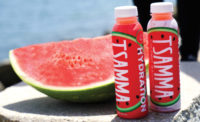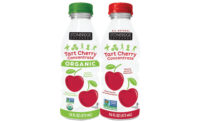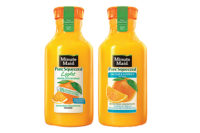Innovation keeps juice, juice drinks market fresh
Pricing, sugar reduction trends continue to impact fruit beverages market

Image courtesy of Capri Sun Group Holding AG
From the earliest civilizations squeezing fruits by hand to the 1900s with companies like Welch’s launching packaged fruit juices for mass consumption, juice and juice drinks have been enjoyed for centuries for their taste and nutritional benefits.
Today, with more consumers seeking “better-for-you” options, experts note that the juice and juice drinks market has seen a spike in demand from consumers interested in healthy alternatives that still taste great.
“Another trend dominating the juice market is an increased consumer preference for higher-quality ingredients and fewer preservatives or unnecessary additives,” says Mitch Madoff, head of retail partnerships at Keychain, New York. “Especially with the influence of social media platforms like TikTok and Instagram, consumers are increasingly more aware of what they’re consuming and are starting to step away from products that are high in processed ingredients.”
Adriana Chychula, consumer insights analyst at Mintel, Chicago, points to innovation as being vital to the juice and juice drinks market.
“The juice and juice drinks market (made up of 100% juice, juice drinks and smoothies) is expected to grow 0.4% in 2024 to total $23.77 billion,” she says. “Nostalgia keeps classics like Capri-Sun relevant while flavor innovation keeps things fresh. All connect to the emotional value of enjoying something in the moment with your senses, which is ultimately the main undercurrent of juice and juice drinks.”

Roger Dilworth, senior analyst at Beverage Marketing Corporation (BMC), Wintersville, Ohio, attributes inflation as the primary reason for volume declines within the market in the past year.
“In 2023, fruit drinks declined in volume by 2.9% while fruit juice volume plummeted by 8% — overall fruit beverage volume decrease was 5.6%,” he says. “While fruit beverages in general have had a subpar performance for most of the past 20 years, the relative weakness in 2023 is due mostly to inflation.”
Segments resonating with consumers
As shifts in consumer preference continue to make a difference in what types of juices are performing better than others, experts highlight which types are performing well and which have been struggling.
“According to scanner data, the segments that have done well are shelf-stable cherry juice and refrigerated pomegranate juice, which may be attributable to their purported health benefits (joint pain relief and ‘antioxidant powerhouse’ respectively),” BMC’s Dilworth says. “Also doing relatively well are refrigerated fruit drinks, which may be due to their affordability.
“On the flip side of affordability, refrigerated orange juice has suffered due to its high price point,” he continues. “Other refrigerated juices have struggled too, probably because of the same reason. The so-called premium/super premium ‘smoothie’ segment has declined precipitously as well, as fewer consumers are inclined to pay high prices for a single-serve container.”
Nostalgia keeps classics like Capri-Sun relevant while flavor innovation keeps things fresh. All connect to the emotional value of enjoying something in the moment with your senses, which is ultimately the main undercurrent of juice and juice drinks.
Keychain’s Madoff highlights how classic flavors and premium options are helping drive growth within the juice and juice drinks market.
“From what we’re seeing on Keychain, classic flavor options continue to lead in this category, including fruit punch, orange juice, and apple juice,” he says. “Instead of adding new flavor options, most brands are looking to broaden their offerings with premium or higher-quality options, which have seen an increase in both demand and performance.
“The trends make sense, especially when it comes to kids’ juices: parents are going to choose the better-for-you option that likely has less sugar and cleaner ingredients,” Madoff continues. “This is also the case for adults, who are often more likely to choose the healthier alternative for themselves.”
Mintel’s Chychula explains that 100% juice carries engagement with consumers, but juice drinks’ price points lift them above in terms of market performance.
“Seventy-four percent of juice drink consumers have purchased 100% juice in the last three months compared to 47% who have purchased juice drinks: but 2024 estimates put the 100% juice segment at $9.79 billion compared to juice drinks’ $13.25 billion,” she explains. “The smoothies segment has historically held less consumer attention (28% engagement in bottled smoothies) and consistently declining market performance to match (minus 11.5% to land at $729 million in 2024).”
Chychula also considers how 100% juice’s simplicity is cutting through consumers’ decision-making process.
“There’s just less thinking involved — consumers don’t have to overanalyze the ingredients or wonder what else is in there,” she says. “They know what they’re getting and can get in and out of stores, which can be sensory nightmares.
“On the other hand, juice drinks are great at being an in-reach pick-me-up,” Chychula continues. “Without much effort, you can make mundane errands less dull with a beverage that introduces you to new flavor combinations and maybe even global inspiration. Smoothies don’t have quite the same appeal — they need to be consumed quickly and compete with homemade or made-to-order options that are fresher and contain just whole food-based ingredients.”
Sugar reduction, fortification a buzz
Although juice and juice drinks still are sought after for their nutritional benefits, experts note that sugar reduction trends have significantly impacted the market.
“When it comes to sugar, many juice brands face a common hurdle: consumers’ growing skepticism over added sugars in juice products,” Keychain’s Madoff says. “This confusion has led consumers to question almost any juice product, leading some to even question 100% fruit juices that contain no added sugars.
“To tackle this and maintain customer loyalty, brands can differentiate themselves by emphasizing a lack of added sugars and focusing on the nutritional benefits of the natural sugars coming from fruits, like vitamins and antioxidants,” he continues.
Mintel’s Chychula, meanwhile, notes the conflict between consumers’ taste preferences and reduced sugar options.
“The dynamic between flavor and sugar is tricky,” Chychula says. “I refer to this as ‘flavor FOMO,’ where consumers acknowledge that too much sugar is an issue but that they would rather have less of their preferred full-strength product when it comes down to it.
“Reformulating to have less sugar runs the risk of altering the flavor, dulling the health halo (usually associated with simplicity or lack of zero-calorie sweeteners) or removing the 100% name designation that consumers’ value,” she continues. “That said, having options for those who either need to be stricter or just want to cut back is important.”
Chychula also highlights how consumers’ relationship with zero-calorie sweeteners, that are nature-aligned sweeteners, brings a sense of safety.
“Forty percent say they would pay more for naturally reduced sugar, and sweeteners that have approachable names are more likely to generate interest among those who haven’t tried them — even among Baby Boomers, who are often comfortable in their routines,” she explains. “The difference in consumer reception of monk fruit compared to allulose — both sourced from plants — is a great example of this.
“Allulose is almost a one-to-one replacement in terms of flavor and baking functionality and has little effect on blood sugar,” she continues. “On the other hand, monk fruit is known to have a bit of an aftertaste and needs other ingredients if it is going to be used in baking or cooking. Not only does monk fruit have higher current engagement than allulose (16% vs. 11%), but more consumers who have not tried monk fruit are interested in it (21%) than those who have not tried allulose (14%).”
BMC’s Dilworth explains how sugar reduction trends have produced a headwind to the market.
“There is the prospect of a ‘holy grail’ in terms of technology that would enable significant sugar reduction without a trade-off in flavor, but this has been on the cards for several years already with no tangible results,” he says. “In the meantime, there has been a bigger emphasis lately on low- and zero-sugar SKUs from marketers such as Minute Maid, Ocean Spray and Welch’s.”
As far as fortification trends like probiotics, protein and immune-support impacting the market, Dilworth suspects that there were more products promising immune support in the COVID-19 era.
“While these have not panned out for the most part, there will continue to be introductions with zinc and vitamin fortification,” he says. “There does not seem to be a lot of activity in the digestive health arena, aside from GoodBelly, but that could conceivably change with the success of gut pops like Olipop and poppi.”
Keychain’s Madoff highlights how increased consumer demand for beverages that have added probiotics, antioxidants, vitamins, and minerals is influencing the juice market.
“The same thing is happening in the juice market and today’s consumer is more likely to choose an option with added benefits,” he says. “We’re even seeing this trend when it comes to children’s juices. Most parents buy juice for their children to drink with breakfast or juice boxes for a packed school lunch. Parents are paying closer attention to what’s in their children’s food and drinks, with a particular focus on more probiotics and vitamins, and less sugar, salt and processing.”
Mintel’s Chychula points to consumers’ interest in various ingredients and their health attributes.
“I would say connecting ingredients to the wellness benefits is more common than fortification (except those that are already more established, like vitamin D in orange juice),” she says. “Coconut water is having a bit of a moment — beyond plain coconut water itself, it’s being added to beverages as a food-based source of electrolytes and even being used to reduce sugar without losing 100% name designations.”
Looking ahead
As functional beverage trends continue to impact the juice and juice drinks market, experts anticipate what to expect in the year to come.
“Juice brands will continue to find ways to bring in new consumers while making their existing customers happy with innovative flavors, products, and ingredients,” Keychains’ Madoff says. “Other drink markets like alternative sodas are also seeing continued growth, which means juice brands need to find a way to not only compete with them but also appeal to their audience.
“These better-for-you trends aren’t going anywhere and consumers will continue to look for transparency in ingredients and production processes,” he continues. “This will push brands to focus on more accurately labeling their products and sharing more information about how they source their ingredients.”
Mintel’s Chychula expects more blends that appeal to flavor exploration interests, even if it’s just combining familiar fruits in fresh ways.
“This is also a solution to varied production yields; oranges have had a rough year with drought and disease, and this led to record-high prices that are likely to reappear,” she says.
BMC’s Dilworth anticipates that price points will continue to impact the market in the year to come.
“With the [consumer price index] (CPI) coming down in 2024, fruit drink volume should be flat, or even up nominally, while juices — already at a high price level — are projected to be down in volume by more than 5%,” he concludes.
Looking for a reprint of this article?
From high-res PDFs to custom plaques, order your copy today!






